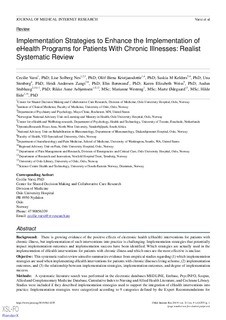| dc.contributor.author | Varsi, Cecilie | |
| dc.contributor.author | Solberg Nes, Lise | |
| dc.contributor.author | Kristjansdottir, Olöf Birna | |
| dc.contributor.author | Kelders, Saskia M | |
| dc.contributor.author | Stenberg, Una | |
| dc.contributor.author | Zangi, Heidi Andersen | |
| dc.contributor.author | Børøsund, Elin | |
| dc.contributor.author | Weiss, Karen Elizabeth | |
| dc.contributor.author | Stubhaug, Audun | |
| dc.contributor.author | Asbjørnsen, Rikke Aune | |
| dc.contributor.author | Westeng, Marianne | |
| dc.contributor.author | Ødegaard, Marte | |
| dc.contributor.author | Eide, Hilde | |
| dc.date.accessioned | 2019-10-22T07:56:26Z | |
| dc.date.available | 2019-10-22T07:56:26Z | |
| dc.date.created | 2019-10-01T13:00:26Z | |
| dc.date.issued | 2019 | |
| dc.identifier.citation | Journal of Medical Internet Research. 2019, 21 (9). | nb_NO |
| dc.identifier.issn | 1438-8871 | |
| dc.identifier.uri | http://hdl.handle.net/11250/2623626 | |
| dc.description | This is an open-access article distributed under the terms of the Creative Commons Attribution License which permits unrestricted use, distribution, and reproduction in any medium, provided the original work, first published in the Journal of Medical Internet Research, is properly cited. The complete bibliographic information, a link to the original publication on http://www.jmir.org/, as well as this copyright and license information must be included. | nb_NO |
| dc.description.abstract | Background: There is growing evidence of the positive effects of electronic health (eHealth) interventions for patients with chronic illness, but implementation of such interventions into practice is challenging. Implementation strategies that potentially impact implementation outcomes and implementation success have been identified. Which strategies are actually used in the implementation of eHealth interventions for patients with chronic illness and which ones are the most effective is unclear.
Objective: This systematic realist review aimed to summarize evidence from empirical studies regarding (1) which implementation strategies are used when implementing eHealth interventions for patients with chronic illnesses living at home, (2) implementation outcomes, and (3) the relationship between implementation strategies, implementation outcomes, and degree of implementation success.
Methods: A systematic literature search was performed in the electronic databases MEDLINE, Embase, PsycINFO, Scopus, Allied and Complementary Medicine Database, Cumulative Index to Nursing and Allied Health Literature, and Cochrane Library. Studies were included if they described implementation strategies used to support the integration of eHealth interventions into practice. Implementation strategies were categorized according to 9 categories defined by the Expert Recommendations for Implementing Change project: (1) engage consumers, (2) use evaluative and iterative strategies, (3) change infrastructure, (4) adapt and tailor to the context, (5) develop stakeholder interrelationships, (6) use financial strategies, (7) support clinicians, (8) provide interactive assistance, and (9) train and educate stakeholders. Implementation outcomes were extracted according to the implementation outcome framework by Proctor and colleagues: (1) acceptability, (2) adoption, (3) appropriateness, (4) cost, (5) feasibility, (6) fidelity, (7) penetration, and (8) sustainability. Implementation success was extracted according to the study authors’ own evaluation of implementation success in relation to the used implementation strategies.
Results: The implementation strategies management support and engagement, internal and external facilitation, training, and audit and feedback were directly related to implementation success in several studies. No clear relationship was found between the number of implementation strategies used and implementation success.
Conclusions: This is the first review examining implementation strategies, implementation outcomes, and implementation success of studies reporting the implementation of eHealth programs for patients with chronic illnesses living at home. The review indicates that internal and external facilitation, audit and feedback, management support, and training of clinicians are of importance for eHealth implementation. The review also points to the lack of eHealth studies that report implementation strategies in a comprehensive way and highlights the need to design robust studies focusing on implementation strategies in the future. | nb_NO |
| dc.language.iso | eng | nb_NO |
| dc.rights | Navngivelse 4.0 Internasjonal | * |
| dc.rights.uri | http://creativecommons.org/licenses/by/4.0/deed.no | * |
| dc.title | Implementation Strategies to Enhance the Implementation of eHealth Programs for Patients With Chronic Illnesses: Realist Systematic Review | nb_NO |
| dc.type | Journal article | nb_NO |
| dc.type | Peer reviewed | nb_NO |
| dc.description.version | publishedVersion | nb_NO |
| dc.rights.holder | ©Cecilie Varsi, Lise Solberg Nes, Olöf Birna Kristjansdottir, Saskia M Kelders, Una Stenberg, Heidi Andersen Zangi, Elin Børøsund, Karen Elizabeth Weiss, Audun Stubhaug, Rikke Aune Asbjørnsen, Marianne Westeng, Marte Ødegaard, Hilde Eide. | nb_NO |
| dc.source.pagenumber | 19 | nb_NO |
| dc.source.volume | 21 | nb_NO |
| dc.source.journal | Journal of Medical Internet Research | nb_NO |
| dc.source.issue | 9 | nb_NO |
| dc.identifier.doi | 10.2196/14255 | |
| dc.identifier.cristin | 1732356 | |
| dc.relation.project | Norges forskningsråd: 256574 | nb_NO |
| cristin.unitcode | 222,56,1,0 | |
| cristin.unitname | Institutt for sykepleie- og helsevitenskap | |
| cristin.ispublished | true | |
| cristin.fulltext | original | |
| cristin.qualitycode | 2 | |

